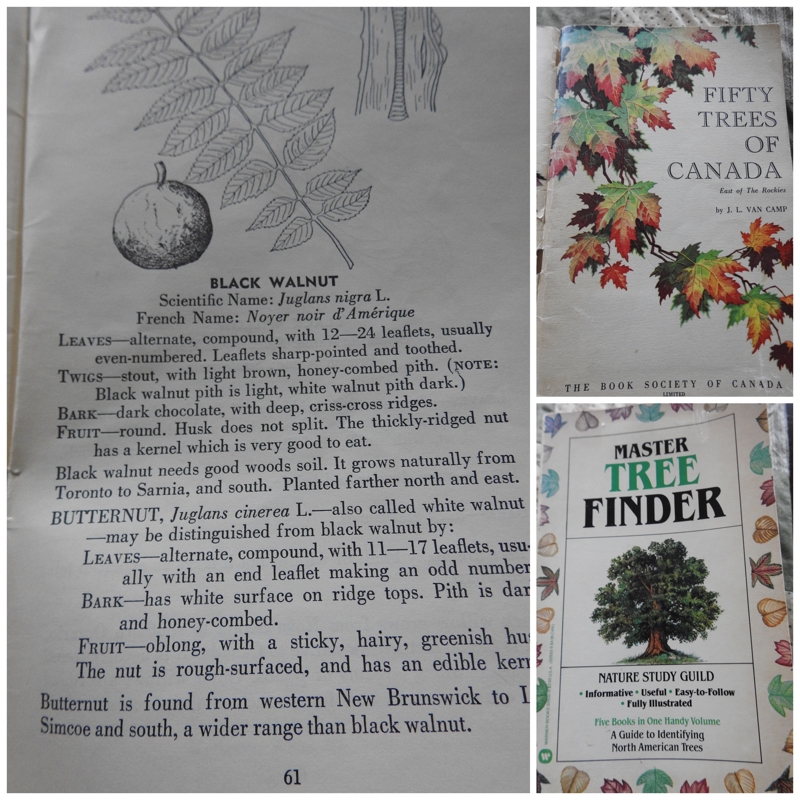The eastern black walnut, or juglans nigra grows wild around, but not on, the property. It grows straight and tall and is a great shade tree.

An old Guiding book, Fifty Trees of Canada, and searching the internet gave me lots of information. The bark is greyish black with thin ridges. The tree can live for upwards of 150 years.

The compound alternative leaves grow fairly quickly. They can be 30-60 cm long.

The lime green, golf ball sized (or larger) fruit is plentiful in the late summer and early fall.
The fruit is:
- light greenish, turning dark brown
- hard shell
- difficult to crack
- tasty walnuts inside
- toxic to dogs
- used to make black ink

The squirrels seem to have figured out how to crack the fruit. They are always hiding the fruit in the gardens or piling them up for a tasty snack.

Last year they would bring the fruit to the composter, and chew them open to eat the walnut inside. Of course the clean up was left to us!

The above photo was taken in late September when the leaves are changing to yellow before they drop off.
It is a valuable tree, because of the wood, but it has its downfalls.
The roots can extend 50 feet or more and it produces something called juglone which will stop the growth of other plants under it and close to it. So if you plan a veggie garden don’t pick a spot with a black walnut tree nearby.

The wood was used by early settlers for fence posts, poles, and roof shingles as it was resistant to decay. Today it is a favourite wood of cabinet makers.
In the past we have collected the fruit and taken it to the wildlife sanctuary for feeding to the critters they rehabilitate.
Do you have a black walnut tree and can you hear the thud, thud, thud as the fruit drops in the Fall?
Re-posting for information as this is the time of year to gather black walnuts.
More from the gardener side: garden areas, bulbs, corms & tubers, plant profiles, seeds & seedpods, veggies & herbs,
Alphabetical posts A B C D E F G H I J K L M N O P Q R S T U V W X Y Z
My series on Alphabetical gardening and my personal alphabet.

SquareMary
We once stayed in a bed and breakfast in Southampton on Lake Huron. All night long, someone’s car alarm would go off at irregular intervals. Someone thought the car owner’s little daughter was playing with the key clicker thing, but actually walnuts were falling off the tree onto the car!
Margy
Don’t think we have any wild black walnut trees around here. When I was little, I would visit my grandparents in Central California. There were groves of walnut trees nearby. The root stock was usually black walnut with other types of high producing walnuts grafted on top. You could easily see where the hardy black walnut roots and trunk ended and the producing variety began. I was lucky that Mike Martin put his new book into the Amazon Unlimited Kindle program. Wayne and I subscribe using a family account so I was able to read it at no extra cost. Mike does get paid based on the number of pages an Unlimited customer reads. Wayne uses this option for three of his books so we can give them away free once every three months. – Margy
Myrtle
I grew up on a farm and we had a walnut tree on one of the lawns. We used to
gather up the nuts and make pipes out of the nuts, There sure was a mess on the lawn. I have no idea what kind of chestnut tree it was.
Judee
I feel like I’ve seen a tree like that in our neighborhood near the main road. I wondered what it was. It’s interesting to find out what some of the older trees are. Two years ago, I took a walk to an area that I frequently drove by and saw lots of people collecting something from these trees. They showed me that they were actually 12 chestnut trees that lined the road. The chestnuts were beautiful and plentiful..
Jennifer A. Jilks
We have some in town. I don’t think we have any here! Happy gardening!